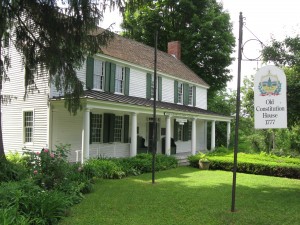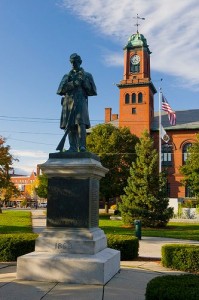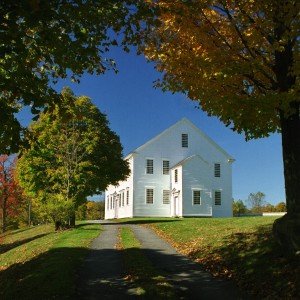A Deep Sense of Place
When visitors to the Northern Connecticut River say they feel like they’ve come home, it’s because our valley evokes the way things used to be. Early on a summer morning, as the mist rises off the water, it’s possible to picture the river as indigenous people experienced it thousands of years ago. And many of our downtown centers and villages survive intact from the 19th century, when the classic American Main Street was invented.
 Here, the natural and built environments are balanced on a human scale, like the covered bridges that span the Connecticut and its tributaries. These and other historic bridges have tamed the topography in our water-shaped landscape, linking town and country.
Here, the natural and built environments are balanced on a human scale, like the covered bridges that span the Connecticut and its tributaries. These and other historic bridges have tamed the topography in our water-shaped landscape, linking town and country.
In rural farming villages and urban commercial centers, our distinctive regional architecture tells a 250-year-old tale of settlement, growth, and changes in technology and fashion. You can read the story in the additions to a barn, in the layers of growth where a waterfall’s power spawned a small city, or factories where inspired tinkerers invented the machine tool industry.
Some things are just a memory, like the great log drives on the river. But you can still stroll down streets where the buildings have hardly changed in more than a hundred years, where the past and present persist together.
Historical Museums
 The Connecticut River Valley is famous for its machine tool factories and their invention of what is known as “precision manufacturing.” The most notable was the Robbins and Lawrence Armory and Machine Shop, in Windsor, VT. In the mid-1800s, the company was an innovator in the new field of manufacturing interchangeable parts, stimulating the growth of mass production and accelerating the industrial revolution. Its large brick factory, built in 1846, is now a National Historic Landmark and the home of the American Precision Museum. The Museum preserves the heritage of the mechanical arts, celebrates the ingenuity of our talented forebears, and explores the effects of their work on our everyday lives. It holds the largest collection of historically significant machine tools in the nation.
The Connecticut River Valley is famous for its machine tool factories and their invention of what is known as “precision manufacturing.” The most notable was the Robbins and Lawrence Armory and Machine Shop, in Windsor, VT. In the mid-1800s, the company was an innovator in the new field of manufacturing interchangeable parts, stimulating the growth of mass production and accelerating the industrial revolution. Its large brick factory, built in 1846, is now a National Historic Landmark and the home of the American Precision Museum. The Museum preserves the heritage of the mechanical arts, celebrates the ingenuity of our talented forebears, and explores the effects of their work on our everyday lives. It holds the largest collection of historically significant machine tools in the nation.
The Springfield (VT) Telescope Makers keep alive the traditions established at the Stellafane Observatory, also a National Historic Landmark. The Observatory played a pioneering role in amateur telescope making and popular astronomy in the United States. The site contains the group’s original clubhouse (1924), and the first large optical telescope (1930) built and owned by this kind of amateur society. Both clubhouse and telescope have remained in continuous use, preserved essentially in their original condition. Annual conventions attract thousands of amateur telescope makers and astronomers from many countries.
 An architectural gem of the Byway region is the Rockingham Meeting House, a National Historic Landmark just off Route 103 in Rockingham, VT. A rare 18th century New England meeting house of the “second period” type, it is virtually unaltered on the exterior or interior. Its overall shape evokes Medieval timber frames and Puritan ideals, but it also includes Georgian-style details that are unmatched among surviving New England meeting houses of its time. It survives from the period when Church and State were combined, and European immigrants built, at public expense, structures employed for both religious and civic purposes.
An architectural gem of the Byway region is the Rockingham Meeting House, a National Historic Landmark just off Route 103 in Rockingham, VT. A rare 18th century New England meeting house of the “second period” type, it is virtually unaltered on the exterior or interior. Its overall shape evokes Medieval timber frames and Puritan ideals, but it also includes Georgian-style details that are unmatched among surviving New England meeting houses of its time. It survives from the period when Church and State were combined, and European immigrants built, at public expense, structures employed for both religious and civic purposes.
The Fort at No. 4 Living History Museum in Charlestown, NH, offers a glimpse of what life was like when the Northern Valley was a frontier in the mid-1700s. Sited on the banks of the Connecticut River, the Fort recreates and interprets the first permanent Euro-American settlement in the upper Connecticut River Valley, in 1744. Originally a log enclosure surrounding a number of dwellings at Charlestown’s present-day village center, the fort is now represented by a reconstructed log museum at the nearby site of a Contact Period Abenaki village. In addition to its exhibits, the Fort has maintained a busy calendar of re-enactments and programs.
The Salmon P. Chase Birthplace honors a man who served in all three branches of the Federal Government and lived here for the first eight years of his life. Before the Civil War, As a U.S. Senator, he fought to end slavery, before serving as Secretary of the Treasury. In 1864 President Abraham Lincoln appointed him Chief Justice of the United States Supreme Court. Less than six months later Chase administered the Presidential oath of office to Andrew Johnson, and in 1868 presided over the Johnson impeachment trial. The National Historic Landmark is located on Route 12A in Cornish, NH.
The Poore Family Homestead in Stewartstown, NH illustrates the inventive and physically demanding way of life that existed prior to rural electrification. The protected 100-acre property displays the 1826 homestead, barns, furnishings, and tools of this early hill farm, reflecting the traditional spirit, values, and way of life of settlers of the Connecticut River Valley headwaters. The large barn, with its impressive high drive, shelters displays of original farm machinery and household necessaries used by generations of the Poore family: a full loom, spinning wheels, the original hay wagon carriages, and sleighs, farm tools, games, clothing, medicines, journals, and Civil War-era letters. Located near Beaver Brook Falls, the farm is open to the public during the summer.
For more on Vermont and New Hampshire history, visit the New Hampshire Historical Society and the Vermont Historical Society.
Historic Markers
State historic markers in the Byway region offer glimpses into an extraordinary array of people and events that have shaped our history. Some refer to tangible reminders like a covered bridge or venerable house. Others mark events that may have passed and left no trace. Download the text and location of the Historic Markers Along the Connecticut River Byway.
Our Travel the Byway Itineraries and Interactive Map will guide you through the natural, historic, and cultural highlights of each region.